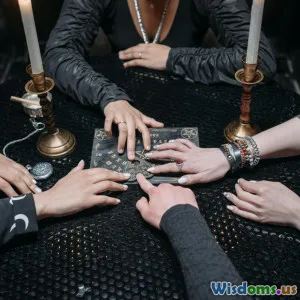
Are Ouija Boards Dangerous or Just a Game?
7 min read Explore the truth behind Ouija boards: harmless fun or a gateway to the supernatural? (0 Reviews)
Are Ouija Boards Dangerous or Just a Game?
Introduction
The Ouija board—an innocuous-looking flat board printed with letters, numbers, and spirits' names—has intrigued millions for over a century. Often found at parlor games and Halloween parties, it invites users to place their fingers on a planchette to supposedly communicate with spirits from beyond. But beneath this seemingly innocent pastime, many wonder: are Ouija boards dangerous or purely a harmless game?
This question has stirred debates that mix folklore, paranormal claims, psychological science, and pop culture horror tales. Whether approached with skepticism or with reverence, the Ouija board remains an enigmatic artifact at the crossroads of entertainment and supernatural mystique.
In this article, we delve deeply into the history, psychological explanations, documented risks, and spiritual perspectives surrounding Ouija boards. Our goal: to demystify and educate, enabling you to decide for yourself whether this curious artifact is a harmless toy or a risky supernatural tool.
The Origins and Cultural Impact of the Ouija Board
Historical Background
The Ouija board was patented in 1891 by Charles Kennard and popularized by social entrepreneur Elijah Bond and later William Fuld. Initially marketed as a parlor game akin to talking boards, its mysterious allure soon grew from its purported ability to summon otherworldly spirits.
It was part of a broader 19th-century surge in spiritualism, reflecting society’s fascination with death and the afterlife. Spiritualism provided solace and connection, especially following devastating events like the Civil War and the 1918 influenza pandemic, times when many sought comfort from loved ones on the other side.
Pop Culture and Media Influence
Movies like The Exorcist (1973) and Ouija (2014) have sensationalized the board’s powers, often linking it to demonic possession and paranormal harm. Media portrayals significantly amplified fear and mystery, shaping public perceptions of Ouija boards far beyond their origins as simple amusement.
Psychological Explanations: The Science Behind the Planchette
Ideomotor Effect
One of the leading explanations for Ouija’s “spirit communication” is the ideomotor effect—unconscious, involuntary muscle movements that guide the planchette without participants realizing they’re controlling it. Studies in cognitive science demonstrate this with compelling evidence; users genuinely believe the planchette moves independently when, in fact, it’s their own subtle motions.
Confirmation Bias and Group Dynamics
Experiments also highlight how expectations can influence Ouija outcomes. If participants anticipate meaningful messages, they are more likely to interpret random movements as coherent responses. Group dynamics foster a collective reinforcement of beliefs, which can escalate the perceived supernatural experience.
Are Ouija Boards Dangerous? Myth Versus Reality
Physical and Psychological Risks
While Ouija boards themselves pose no proven physical harm—the boards are just wood or plastic—psychological risks can be more nuanced:
-
Emotional distress: Participants can experience anxiety, fear, or obsession, especially if convinced they contacted malevolent spirits.
-
Suggestibility: Vulnerable individuals might be more susceptible to influence, potentially leading to long-lasting psychological effects.
Real-World Incidents
Despite decades of use by millions, documented cases of Ouija boards causing physical harm or paranormal danger are anecdotal and lack scientific validation. For example, stories of possessions or hauntings often stem from personal beliefs amplified by cultural narratives.
Religious and Spiritual Perspectives
Many religions warn against Ouija use. The Catholic Church and evangelical groups describe boards as gateways to demonic influences, advising adherents to avoid them entirely. Whether viewed as spiritual threats or simple superstition, such perspectives have profound influence across communities.
When to Approach Ouija Boards With Caution
For Entertainment Purposes
Experienced skeptics and psychologists recommend treating Ouija boards strictly as games. Fun in social settings when approached with critical minds and awareness of psychology can prevent undue fear.
For Individuals Sensitive to Paranormal Beliefs
If you find yourself highly suggestible, anxious, or fearful about supernatural matters, using a Ouija board may trigger unwanted stress.
Children and Vulnerable Populations
The board is not recommended for young children who might not differentiate between play and reality, nor for individuals experiencing mental health challenges that exacerbate paranoia or hallucinations.
Conclusion: Myth, Science, and Personal Belief
Ultimately, whether Ouija boards are dangerous or just a game depends heavily on individual experience, belief, and cultural context. Scientifically, the board’s eerie messages stem from psychological phenomena rather than mystical forces. It functions as a mirror reflecting the subconscious of its users.
However, the power of belief remains potent. For some, the spiritual realm remains real and forbidding, rendering any game connected to it potentially perilous. For others, it’s no more than a curious cultural artifact and source of entertainment.
Approach Ouija boards with informed curiosity and personal discretion. Recognize the psychological mechanics, respect differing spiritual views, and prioritize your mental well-being. The board’s true danger lies less in supernatural forces and more in how human minds interact with it.
Whether you see the Ouija board as a harmless pastime or a mystical conduit, this enduring enigma continues its place in the fascinating junction between mystery and the scientific understanding of human cognition.
References & Further Reading
- Braude, Stephen E. The Limits of Influence: Psychokinesis and the Philosophy of Science. (2007)
- Wiseman, Richard. "Testing for Baseline Ideomotor Action with a Ouija Board". The Skeptical Inquirer. (2005)
- Keeley, James F. "Spiritualism and the Occult in Nineteenth-Century America". American Historical Review. (1995)
Rate the Post
User Reviews
Popular Posts





















